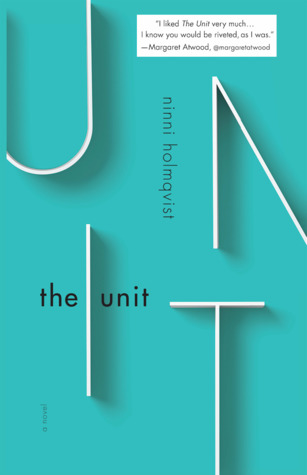
Ninni Holmqvist: The Unit is a dystopia set in a near future. Question: The Unit is not set in the present, but its echoes of present-day issues are clear and ominous. Ninni Holmqvist has created a debut novel of humor, sorrow, and rage about love, the close bonds of friendship, and about a cynical, utilitarian way of thinking disguised as care. The Unit is a gripping exploration of a society in the throes of an experiment, in which the “dispensable” ones are convinced under gentle coercion of the importance of sacrificing for the “necessary” ones. Dorrit is faced with compliance or escape, and.well, then what? But when she meets a man inside the Unit and falls in love, the extraordinary becomes a reality and life suddenly turns unbearable.

She is resigned to her fate and discovers her days there to be rather consoling and peaceful. Despite the ruthless nature of this practice, the ethos of this near-future society and the Unit is to take care of others, and Dorrit finds herself living under very pleasant conditions: well-housed, well-fed, and well-attended. In the Unit they are expected to contribute themselves for drug and psychological testing, and ultimately donate their organs, little by little, until the final donation. Here, women over the age of fifty and men over sixty–single, childless, and without jobs in progressive industries–are sequestered for their final few years they are considered outsiders. She is promised a nicely furnished apartment inside the Unit, where she will make new friends, enjoy the state of the art recreation facilities, and live the few remaining days of her life in comfort with people who are just like her.

One day in early spring, Dorrit Weger is checked into the Second Reserve Bank Unit for biological material. "synopsis" may belong to another edition of this title. But she soon falls in love, and this unexpected, improbable happiness throws the future into doubt.Ĭlinical and haunting, The Unit is a modern-day classic and a chilling cautionary tale about the value of human life. When Dorrit Weger arrives at the Unit, she resigns herself to this fate, seeking only peace in her final days. It’s an idyllic place, but there’s a catch: the residents-known as dispensables-must donate their organs, one by one, until the final donation. They’re given lavish apartments set amongst beautiful gardens and state-of-the-art facilities they’re fed elaborate gourmet meals, surrounded by others just like them. Ninni Holmqvist’s uncanny dystopian novel envisions a society in the not-so-distant future, where women over fifty and men over sixty who are unmarried and childless are sent to a retirement community called the Unit.


"I enjoyed The Unit very much.I know you will be riveted, as I was." -Margaret Atwood, work by Marge Piercy and Margaret Atwood, The Unit is as though-provoking as it is compulsively readable.” -Jessica Crispin, NPR.org


 0 kommentar(er)
0 kommentar(er)
